System Development Analysis Report for Mobile Technology System
VerifiedAdded on 2022/11/13
|12
|1373
|198
Report
AI Summary
This report presents a system development analysis for a mobile technology system. It begins by defining functional and non-functional requirements using the FURPS+ framework, followed by a stakeholder analysis identifying internal and external stakeholders, including the owner, employees, administrator, project manager, and IT personnel. A questionnaire is designed to gather information from operational stakeholders, combining open and closed-ended questions. A domain model class diagram illustrates the system's data structure. Furthermore, the report includes brief and fully developed use case descriptions, a use case diagram, an activity diagram, and a system sequence diagram to detail the system's functionalities and interactions. The analysis focuses on data sharing, security, and automation within the mobile technology context, aiming to improve efficiency and coordination.
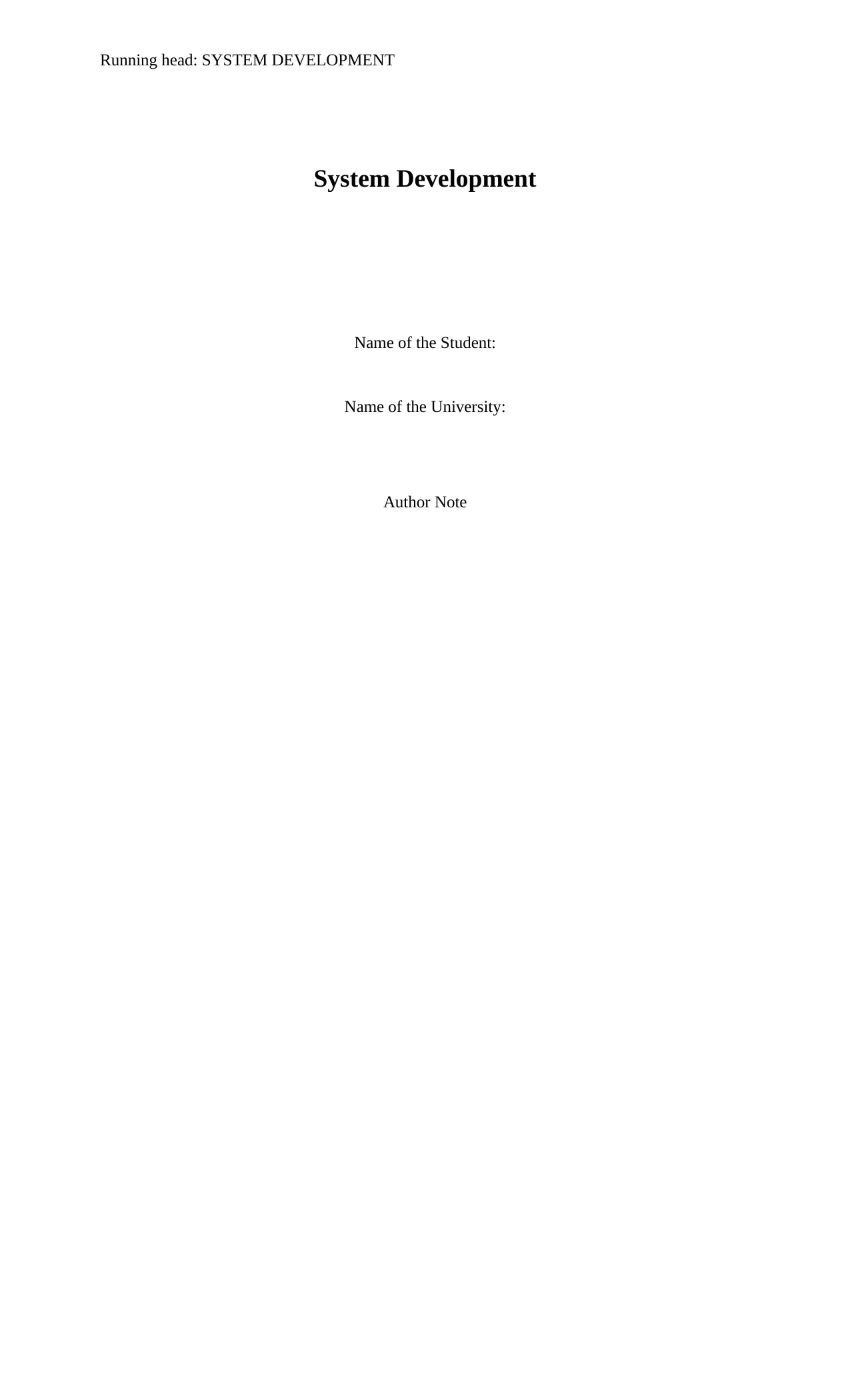
Running head: SYSTEM DEVELOPMENT
System Development
Name of the Student:
Name of the University:
Author Note
System Development
Name of the Student:
Name of the University:
Author Note
Paraphrase This Document
Need a fresh take? Get an instant paraphrase of this document with our AI Paraphraser
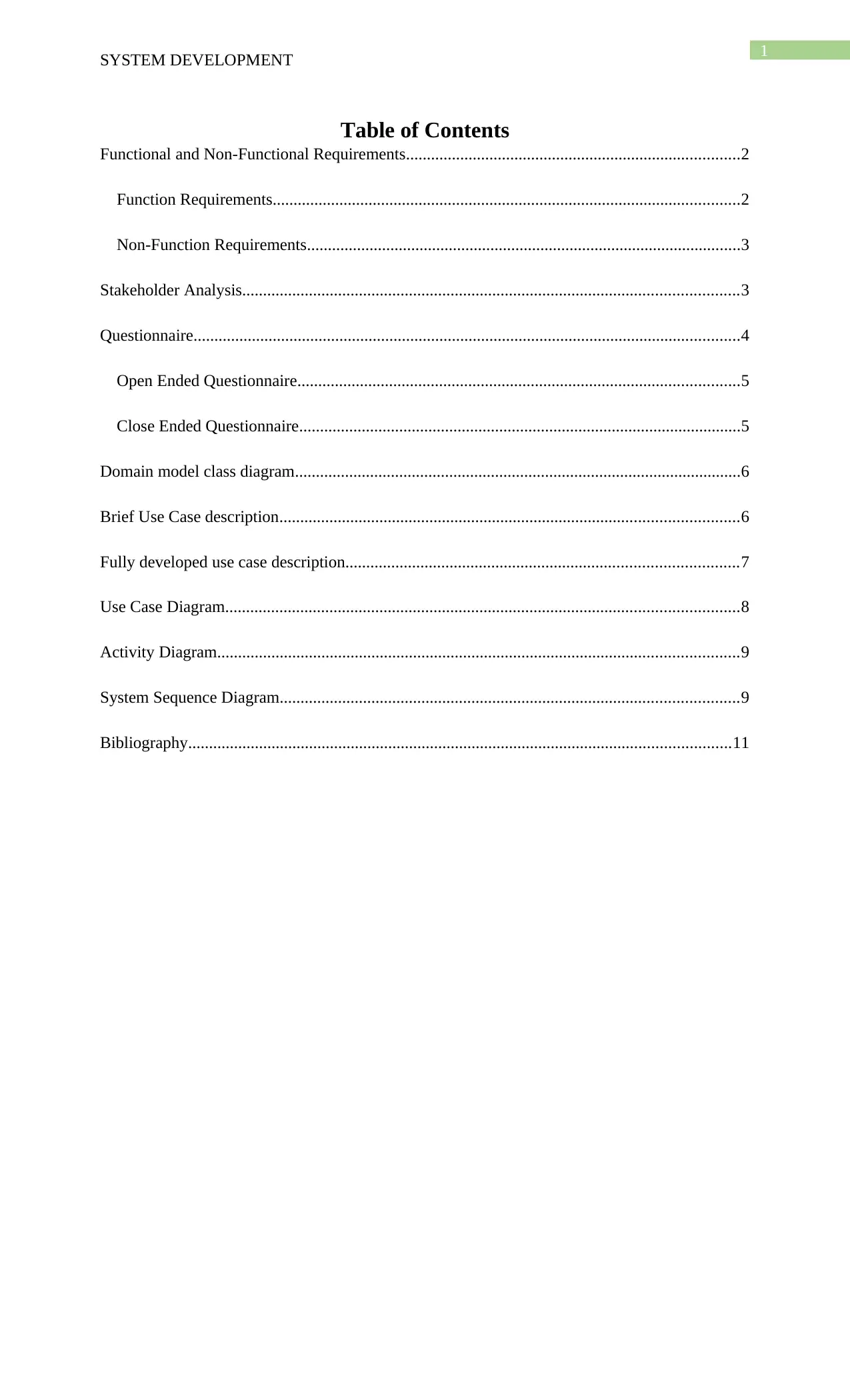
1
SYSTEM DEVELOPMENT
Table of Contents
Functional and Non-Functional Requirements................................................................................2
Function Requirements................................................................................................................2
Non-Function Requirements........................................................................................................3
Stakeholder Analysis.......................................................................................................................3
Questionnaire...................................................................................................................................4
Open Ended Questionnaire..........................................................................................................5
Close Ended Questionnaire..........................................................................................................5
Domain model class diagram...........................................................................................................6
Brief Use Case description..............................................................................................................6
Fully developed use case description..............................................................................................7
Use Case Diagram...........................................................................................................................8
Activity Diagram.............................................................................................................................9
System Sequence Diagram..............................................................................................................9
Bibliography..................................................................................................................................11
SYSTEM DEVELOPMENT
Table of Contents
Functional and Non-Functional Requirements................................................................................2
Function Requirements................................................................................................................2
Non-Function Requirements........................................................................................................3
Stakeholder Analysis.......................................................................................................................3
Questionnaire...................................................................................................................................4
Open Ended Questionnaire..........................................................................................................5
Close Ended Questionnaire..........................................................................................................5
Domain model class diagram...........................................................................................................6
Brief Use Case description..............................................................................................................6
Fully developed use case description..............................................................................................7
Use Case Diagram...........................................................................................................................8
Activity Diagram.............................................................................................................................9
System Sequence Diagram..............................................................................................................9
Bibliography..................................................................................................................................11
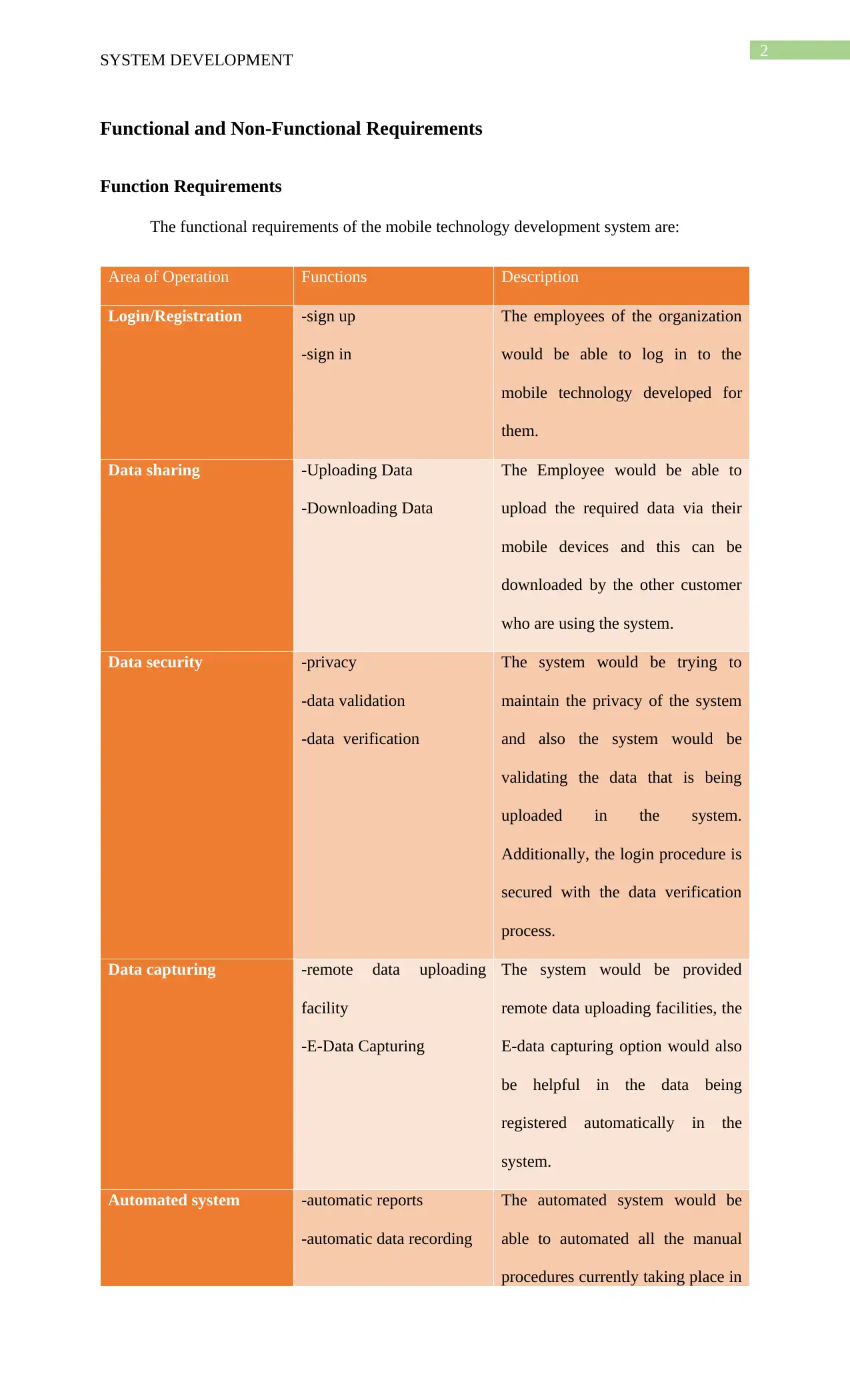
2
SYSTEM DEVELOPMENT
Functional and Non-Functional Requirements
Function Requirements
The functional requirements of the mobile technology development system are:
Area of Operation Functions Description
Login/Registration -sign up
-sign in
The employees of the organization
would be able to log in to the
mobile technology developed for
them.
Data sharing -Uploading Data
-Downloading Data
The Employee would be able to
upload the required data via their
mobile devices and this can be
downloaded by the other customer
who are using the system.
Data security -privacy
-data validation
-data verification
The system would be trying to
maintain the privacy of the system
and also the system would be
validating the data that is being
uploaded in the system.
Additionally, the login procedure is
secured with the data verification
process.
Data capturing -remote data uploading
facility
-E-Data Capturing
The system would be provided
remote data uploading facilities, the
E-data capturing option would also
be helpful in the data being
registered automatically in the
system.
Automated system -automatic reports
-automatic data recording
The automated system would be
able to automated all the manual
procedures currently taking place in
SYSTEM DEVELOPMENT
Functional and Non-Functional Requirements
Function Requirements
The functional requirements of the mobile technology development system are:
Area of Operation Functions Description
Login/Registration -sign up
-sign in
The employees of the organization
would be able to log in to the
mobile technology developed for
them.
Data sharing -Uploading Data
-Downloading Data
The Employee would be able to
upload the required data via their
mobile devices and this can be
downloaded by the other customer
who are using the system.
Data security -privacy
-data validation
-data verification
The system would be trying to
maintain the privacy of the system
and also the system would be
validating the data that is being
uploaded in the system.
Additionally, the login procedure is
secured with the data verification
process.
Data capturing -remote data uploading
facility
-E-Data Capturing
The system would be provided
remote data uploading facilities, the
E-data capturing option would also
be helpful in the data being
registered automatically in the
system.
Automated system -automatic reports
-automatic data recording
The automated system would be
able to automated all the manual
procedures currently taking place in
⊘ This is a preview!⊘
Do you want full access?
Subscribe today to unlock all pages.

Trusted by 1+ million students worldwide
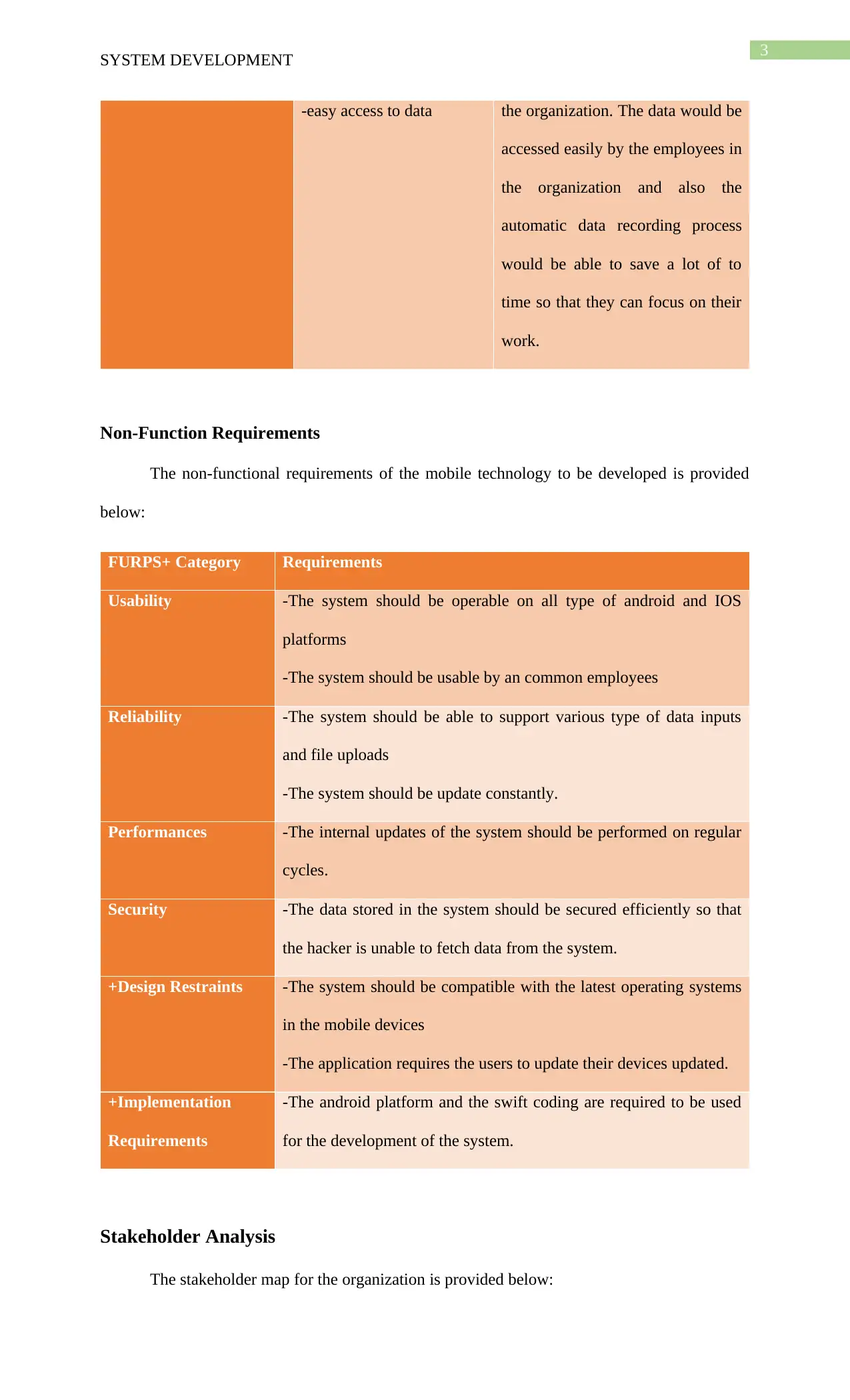
3
SYSTEM DEVELOPMENT
-easy access to data the organization. The data would be
accessed easily by the employees in
the organization and also the
automatic data recording process
would be able to save a lot of to
time so that they can focus on their
work.
Non-Function Requirements
The non-functional requirements of the mobile technology to be developed is provided
below:
FURPS+ Category Requirements
Usability -The system should be operable on all type of android and IOS
platforms
-The system should be usable by an common employees
Reliability -The system should be able to support various type of data inputs
and file uploads
-The system should be update constantly.
Performances -The internal updates of the system should be performed on regular
cycles.
Security -The data stored in the system should be secured efficiently so that
the hacker is unable to fetch data from the system.
+Design Restraints -The system should be compatible with the latest operating systems
in the mobile devices
-The application requires the users to update their devices updated.
+Implementation
Requirements
-The android platform and the swift coding are required to be used
for the development of the system.
Stakeholder Analysis
The stakeholder map for the organization is provided below:
SYSTEM DEVELOPMENT
-easy access to data the organization. The data would be
accessed easily by the employees in
the organization and also the
automatic data recording process
would be able to save a lot of to
time so that they can focus on their
work.
Non-Function Requirements
The non-functional requirements of the mobile technology to be developed is provided
below:
FURPS+ Category Requirements
Usability -The system should be operable on all type of android and IOS
platforms
-The system should be usable by an common employees
Reliability -The system should be able to support various type of data inputs
and file uploads
-The system should be update constantly.
Performances -The internal updates of the system should be performed on regular
cycles.
Security -The data stored in the system should be secured efficiently so that
the hacker is unable to fetch data from the system.
+Design Restraints -The system should be compatible with the latest operating systems
in the mobile devices
-The application requires the users to update their devices updated.
+Implementation
Requirements
-The android platform and the swift coding are required to be used
for the development of the system.
Stakeholder Analysis
The stakeholder map for the organization is provided below:
Paraphrase This Document
Need a fresh take? Get an instant paraphrase of this document with our AI Paraphraser
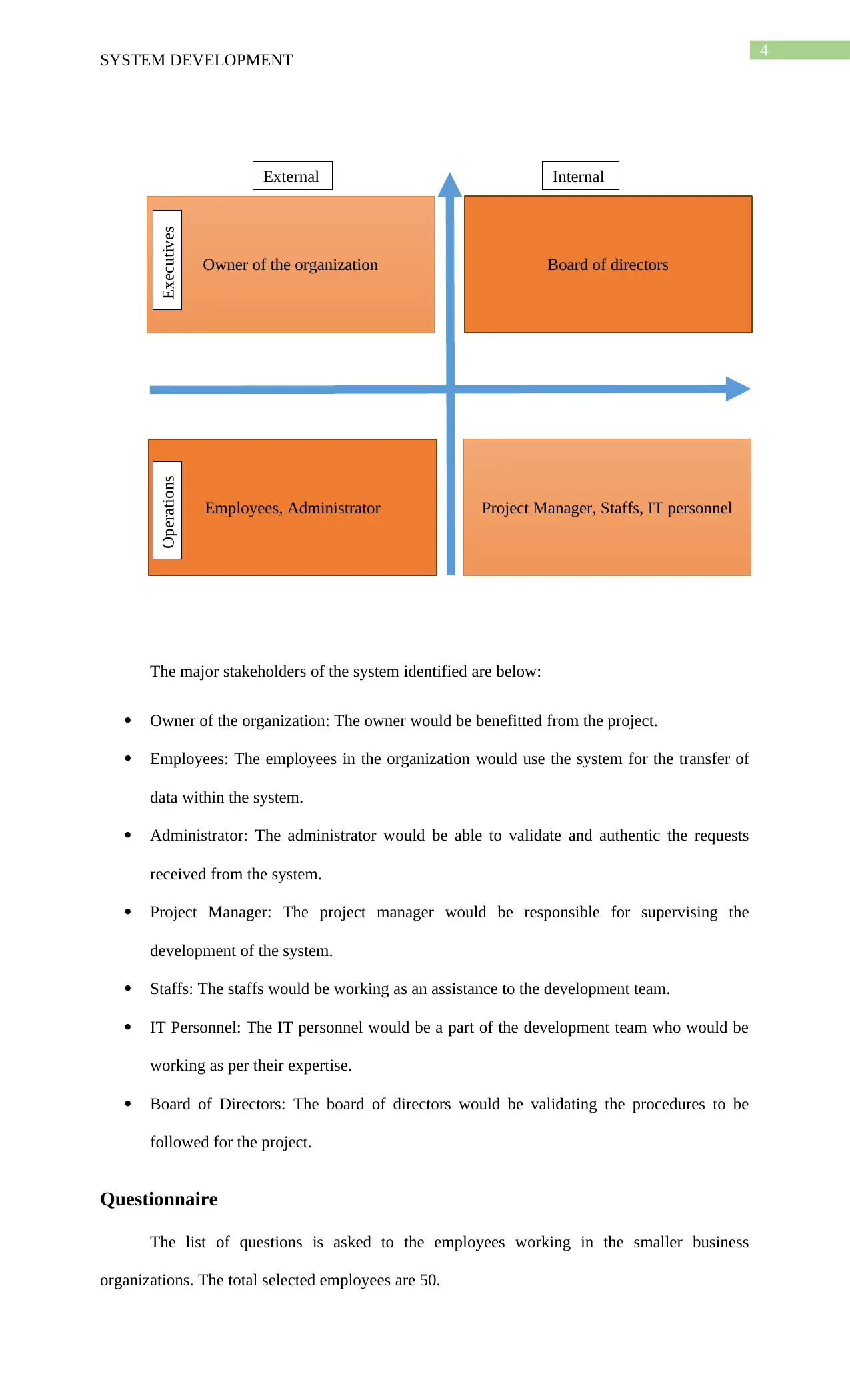
4
External Internal
Owner of the organization Board of directors
Employees, Administrator Project Manager, Staffs, IT personnel
Operations Executives
SYSTEM DEVELOPMENT
The major stakeholders of the system identified are below:
Owner of the organization: The owner would be benefitted from the project.
Employees: The employees in the organization would use the system for the transfer of
data within the system.
Administrator: The administrator would be able to validate and authentic the requests
received from the system.
Project Manager: The project manager would be responsible for supervising the
development of the system.
Staffs: The staffs would be working as an assistance to the development team.
IT Personnel: The IT personnel would be a part of the development team who would be
working as per their expertise.
Board of Directors: The board of directors would be validating the procedures to be
followed for the project.
Questionnaire
The list of questions is asked to the employees working in the smaller business
organizations. The total selected employees are 50.
External Internal
Owner of the organization Board of directors
Employees, Administrator Project Manager, Staffs, IT personnel
Operations Executives
SYSTEM DEVELOPMENT
The major stakeholders of the system identified are below:
Owner of the organization: The owner would be benefitted from the project.
Employees: The employees in the organization would use the system for the transfer of
data within the system.
Administrator: The administrator would be able to validate and authentic the requests
received from the system.
Project Manager: The project manager would be responsible for supervising the
development of the system.
Staffs: The staffs would be working as an assistance to the development team.
IT Personnel: The IT personnel would be a part of the development team who would be
working as per their expertise.
Board of Directors: The board of directors would be validating the procedures to be
followed for the project.
Questionnaire
The list of questions is asked to the employees working in the smaller business
organizations. The total selected employees are 50.
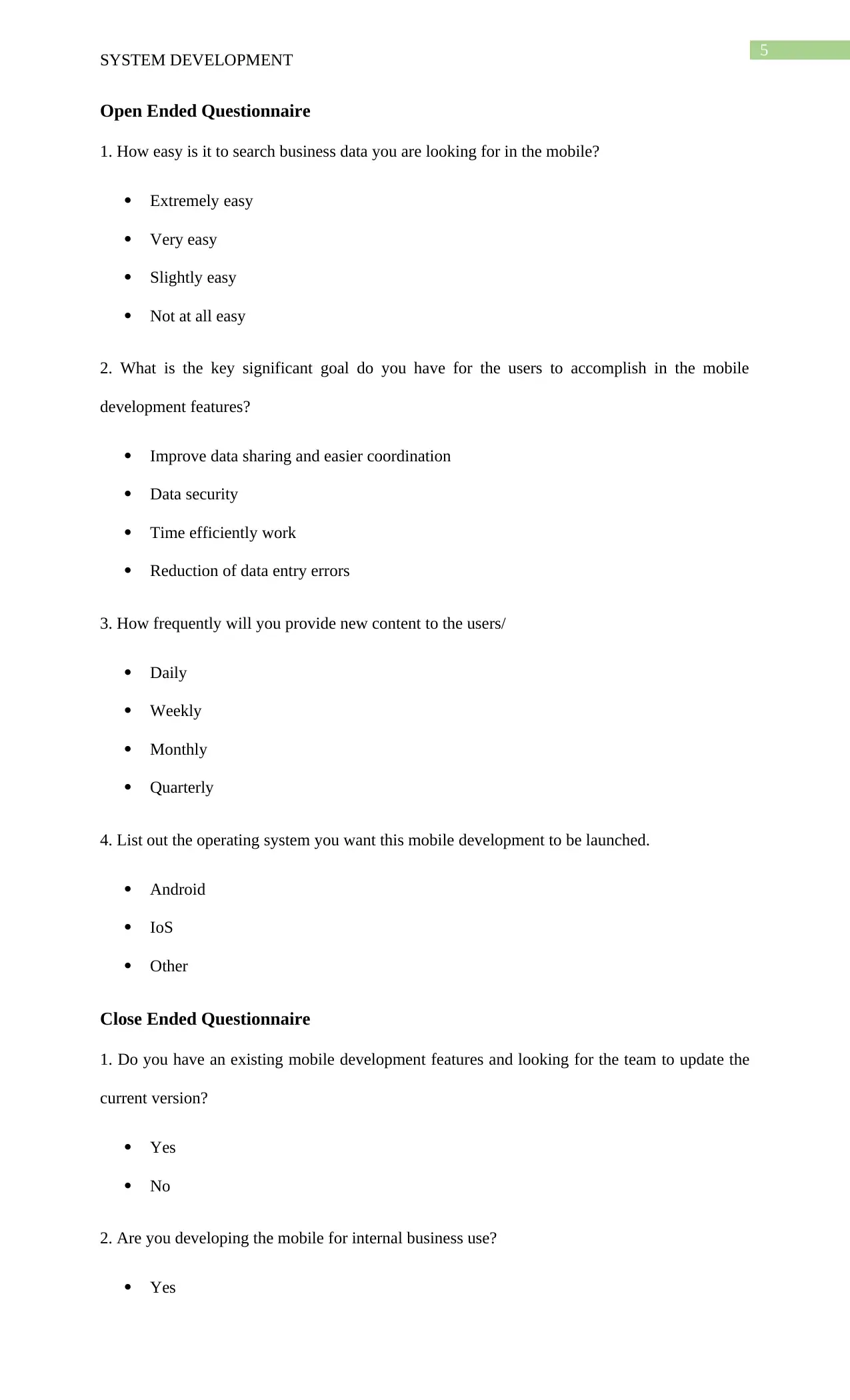
5
SYSTEM DEVELOPMENT
Open Ended Questionnaire
1. How easy is it to search business data you are looking for in the mobile?
Extremely easy
Very easy
Slightly easy
Not at all easy
2. What is the key significant goal do you have for the users to accomplish in the mobile
development features?
Improve data sharing and easier coordination
Data security
Time efficiently work
Reduction of data entry errors
3. How frequently will you provide new content to the users/
Daily
Weekly
Monthly
Quarterly
4. List out the operating system you want this mobile development to be launched.
Android
IoS
Other
Close Ended Questionnaire
1. Do you have an existing mobile development features and looking for the team to update the
current version?
Yes
No
2. Are you developing the mobile for internal business use?
Yes
SYSTEM DEVELOPMENT
Open Ended Questionnaire
1. How easy is it to search business data you are looking for in the mobile?
Extremely easy
Very easy
Slightly easy
Not at all easy
2. What is the key significant goal do you have for the users to accomplish in the mobile
development features?
Improve data sharing and easier coordination
Data security
Time efficiently work
Reduction of data entry errors
3. How frequently will you provide new content to the users/
Daily
Weekly
Monthly
Quarterly
4. List out the operating system you want this mobile development to be launched.
Android
IoS
Other
Close Ended Questionnaire
1. Do you have an existing mobile development features and looking for the team to update the
current version?
Yes
No
2. Are you developing the mobile for internal business use?
Yes
⊘ This is a preview!⊘
Do you want full access?
Subscribe today to unlock all pages.

Trusted by 1+ million students worldwide
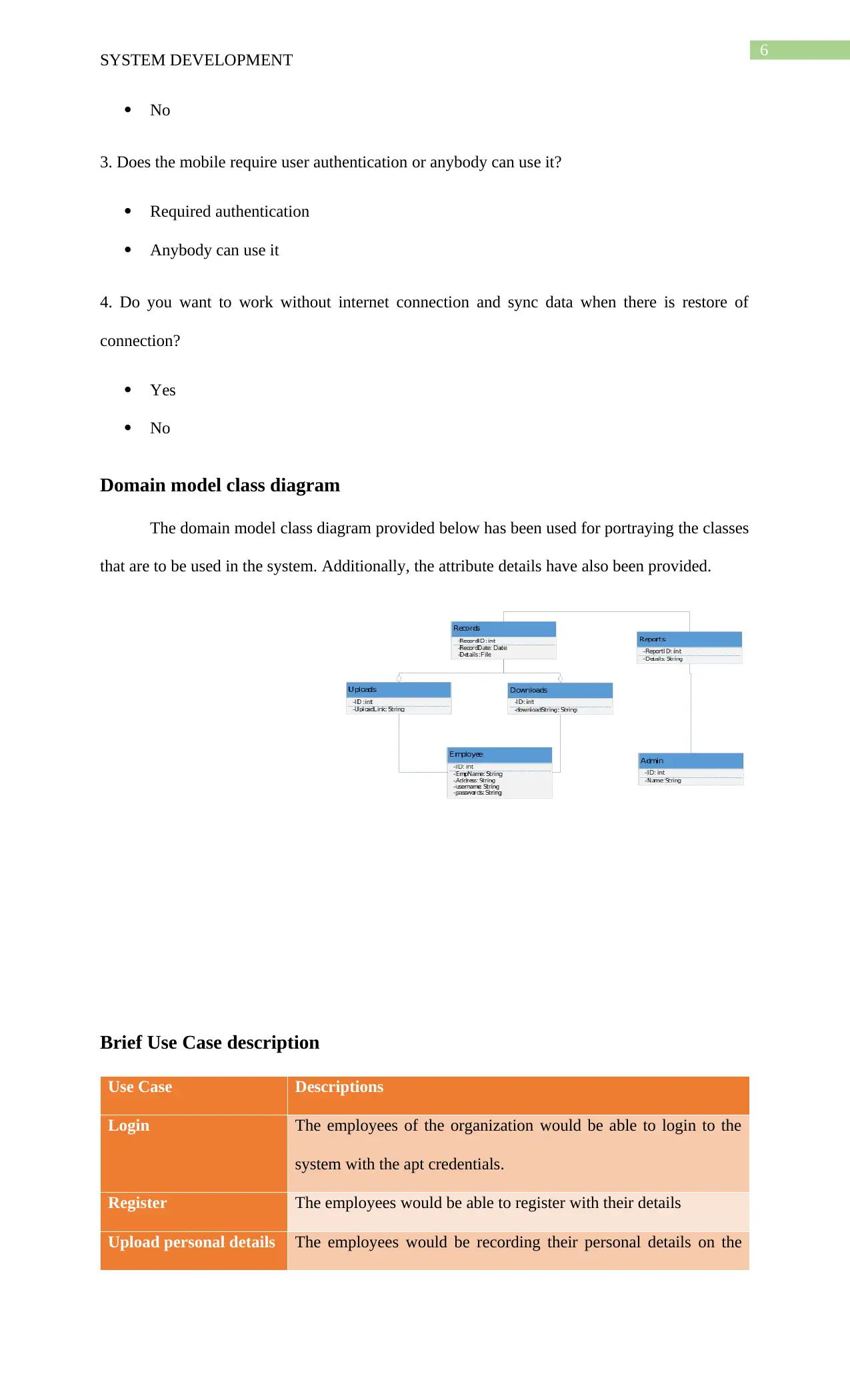
6
SYSTEM DEVELOPMENT
No
3. Does the mobile require user authentication or anybody can use it?
Required authentication
Anybody can use it
4. Do you want to work without internet connection and sync data when there is restore of
connection?
Yes
No
Domain model class diagram
The domain model class diagram provided below has been used for portraying the classes
that are to be used in the system. Additionally, the attribute details have also been provided.
Brief Use Case description
Use Case Descriptions
Login The employees of the organization would be able to login to the
system with the apt credentials.
Register The employees would be able to register with their details
Upload personal details The employees would be recording their personal details on the
SYSTEM DEVELOPMENT
No
3. Does the mobile require user authentication or anybody can use it?
Required authentication
Anybody can use it
4. Do you want to work without internet connection and sync data when there is restore of
connection?
Yes
No
Domain model class diagram
The domain model class diagram provided below has been used for portraying the classes
that are to be used in the system. Additionally, the attribute details have also been provided.
Brief Use Case description
Use Case Descriptions
Login The employees of the organization would be able to login to the
system with the apt credentials.
Register The employees would be able to register with their details
Upload personal details The employees would be recording their personal details on the
Paraphrase This Document
Need a fresh take? Get an instant paraphrase of this document with our AI Paraphraser
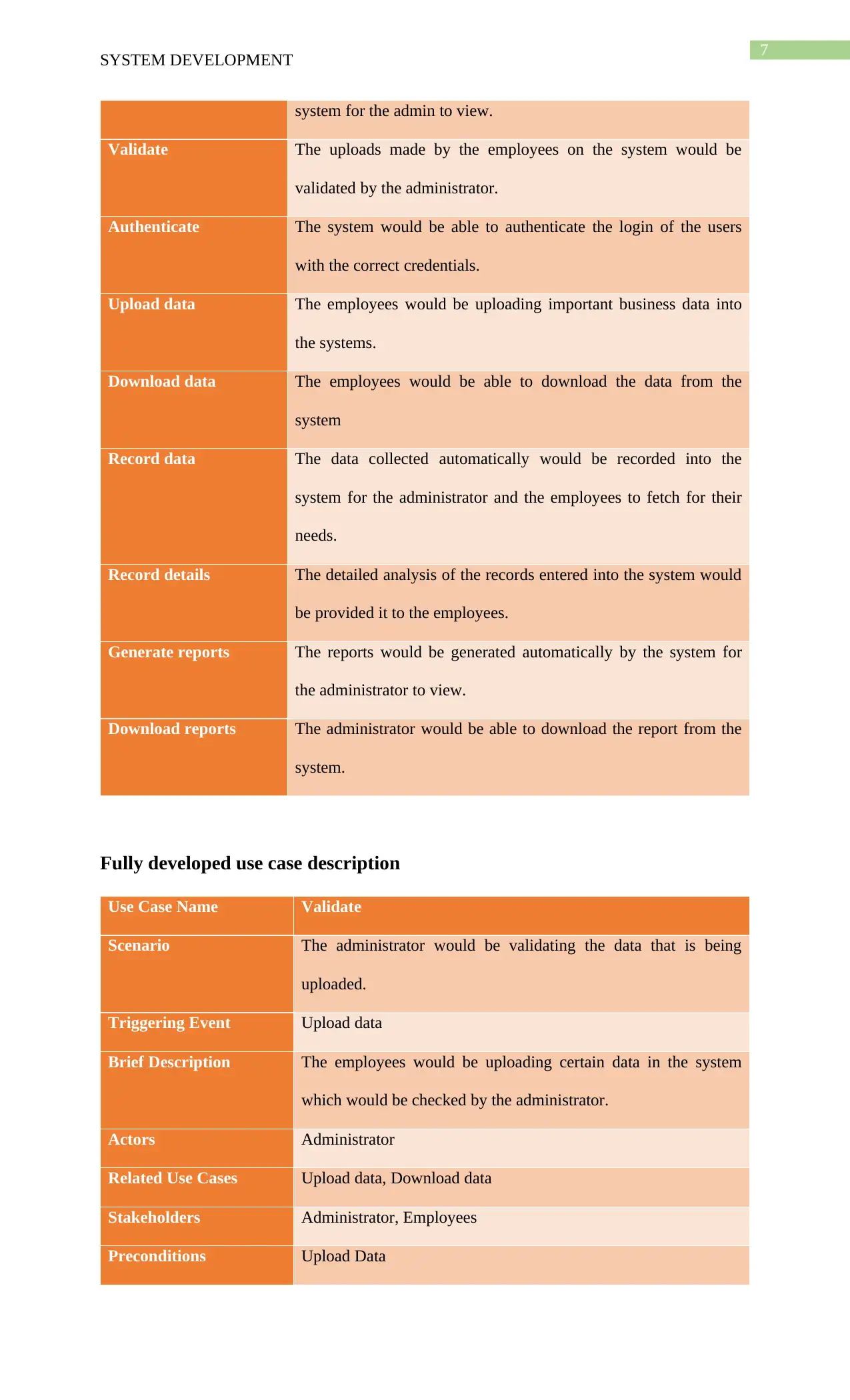
7
SYSTEM DEVELOPMENT
system for the admin to view.
Validate The uploads made by the employees on the system would be
validated by the administrator.
Authenticate The system would be able to authenticate the login of the users
with the correct credentials.
Upload data The employees would be uploading important business data into
the systems.
Download data The employees would be able to download the data from the
system
Record data The data collected automatically would be recorded into the
system for the administrator and the employees to fetch for their
needs.
Record details The detailed analysis of the records entered into the system would
be provided it to the employees.
Generate reports The reports would be generated automatically by the system for
the administrator to view.
Download reports The administrator would be able to download the report from the
system.
Fully developed use case description
Use Case Name Validate
Scenario The administrator would be validating the data that is being
uploaded.
Triggering Event Upload data
Brief Description The employees would be uploading certain data in the system
which would be checked by the administrator.
Actors Administrator
Related Use Cases Upload data, Download data
Stakeholders Administrator, Employees
Preconditions Upload Data
SYSTEM DEVELOPMENT
system for the admin to view.
Validate The uploads made by the employees on the system would be
validated by the administrator.
Authenticate The system would be able to authenticate the login of the users
with the correct credentials.
Upload data The employees would be uploading important business data into
the systems.
Download data The employees would be able to download the data from the
system
Record data The data collected automatically would be recorded into the
system for the administrator and the employees to fetch for their
needs.
Record details The detailed analysis of the records entered into the system would
be provided it to the employees.
Generate reports The reports would be generated automatically by the system for
the administrator to view.
Download reports The administrator would be able to download the report from the
system.
Fully developed use case description
Use Case Name Validate
Scenario The administrator would be validating the data that is being
uploaded.
Triggering Event Upload data
Brief Description The employees would be uploading certain data in the system
which would be checked by the administrator.
Actors Administrator
Related Use Cases Upload data, Download data
Stakeholders Administrator, Employees
Preconditions Upload Data
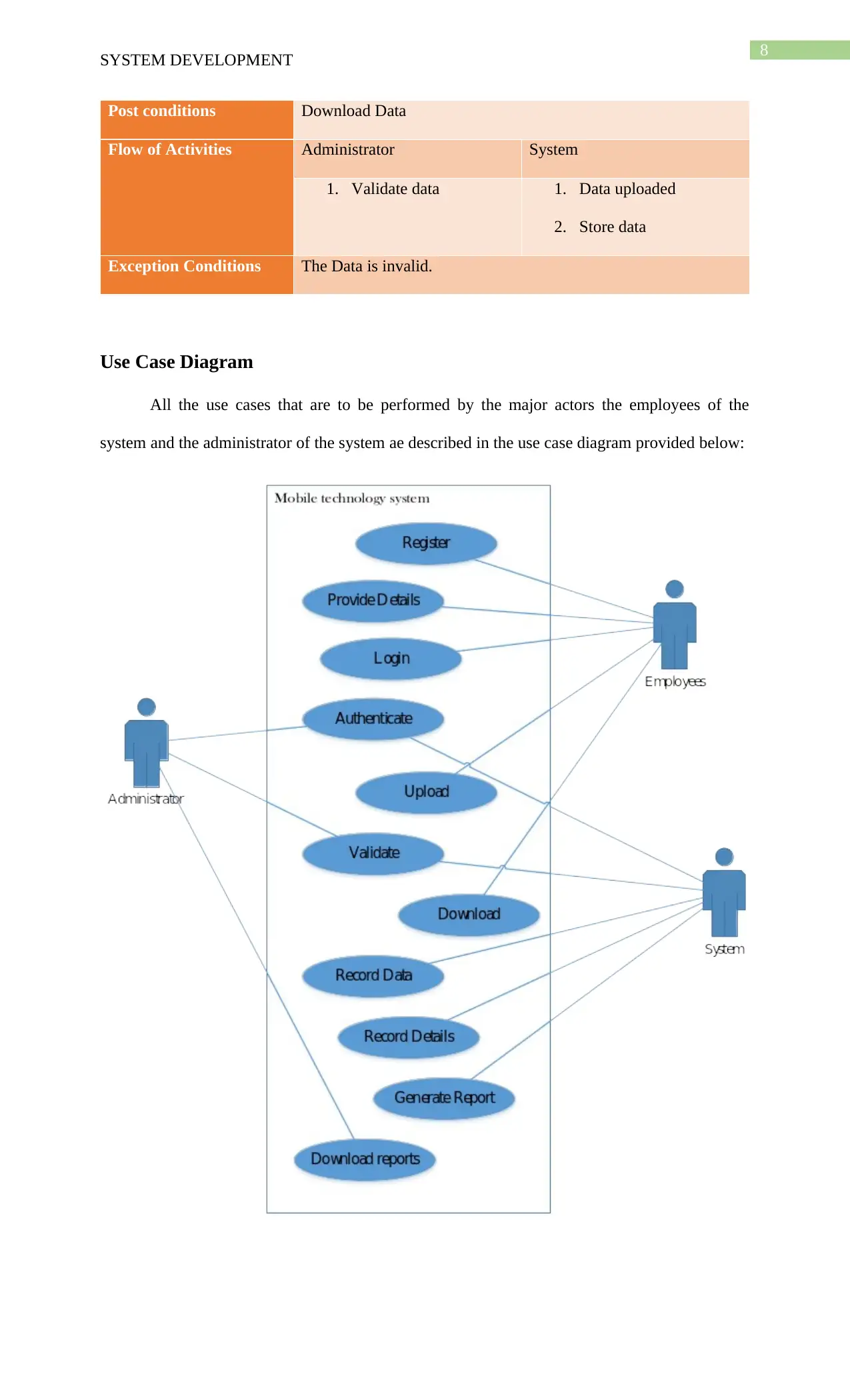
8
SYSTEM DEVELOPMENT
Post conditions Download Data
Flow of Activities Administrator System
1. Validate data 1. Data uploaded
2. Store data
Exception Conditions The Data is invalid.
Use Case Diagram
All the use cases that are to be performed by the major actors the employees of the
system and the administrator of the system ae described in the use case diagram provided below:
SYSTEM DEVELOPMENT
Post conditions Download Data
Flow of Activities Administrator System
1. Validate data 1. Data uploaded
2. Store data
Exception Conditions The Data is invalid.
Use Case Diagram
All the use cases that are to be performed by the major actors the employees of the
system and the administrator of the system ae described in the use case diagram provided below:
⊘ This is a preview!⊘
Do you want full access?
Subscribe today to unlock all pages.

Trusted by 1+ million students worldwide
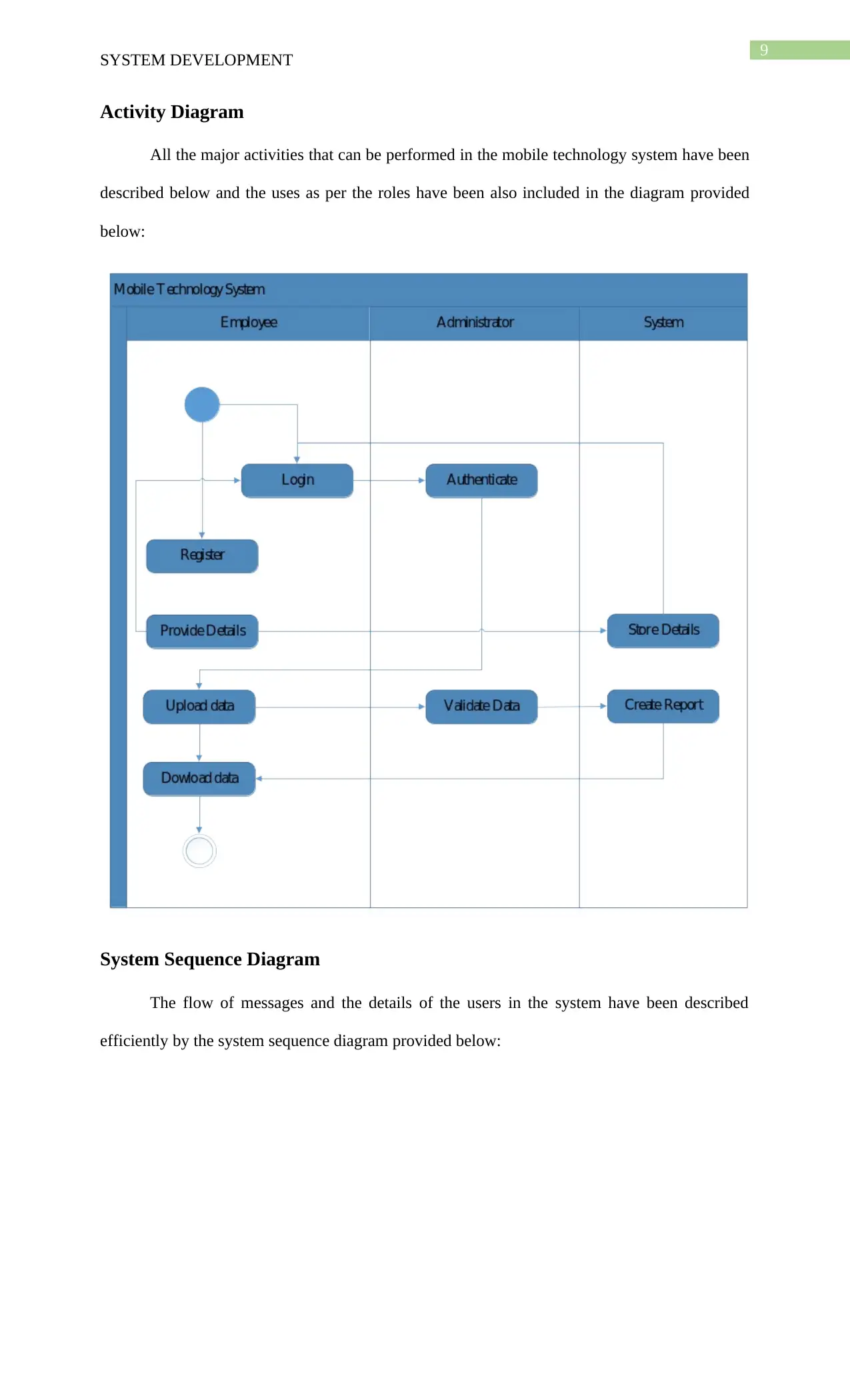
9
SYSTEM DEVELOPMENT
Activity Diagram
All the major activities that can be performed in the mobile technology system have been
described below and the uses as per the roles have been also included in the diagram provided
below:
System Sequence Diagram
The flow of messages and the details of the users in the system have been described
efficiently by the system sequence diagram provided below:
SYSTEM DEVELOPMENT
Activity Diagram
All the major activities that can be performed in the mobile technology system have been
described below and the uses as per the roles have been also included in the diagram provided
below:
System Sequence Diagram
The flow of messages and the details of the users in the system have been described
efficiently by the system sequence diagram provided below:
Paraphrase This Document
Need a fresh take? Get an instant paraphrase of this document with our AI Paraphraser
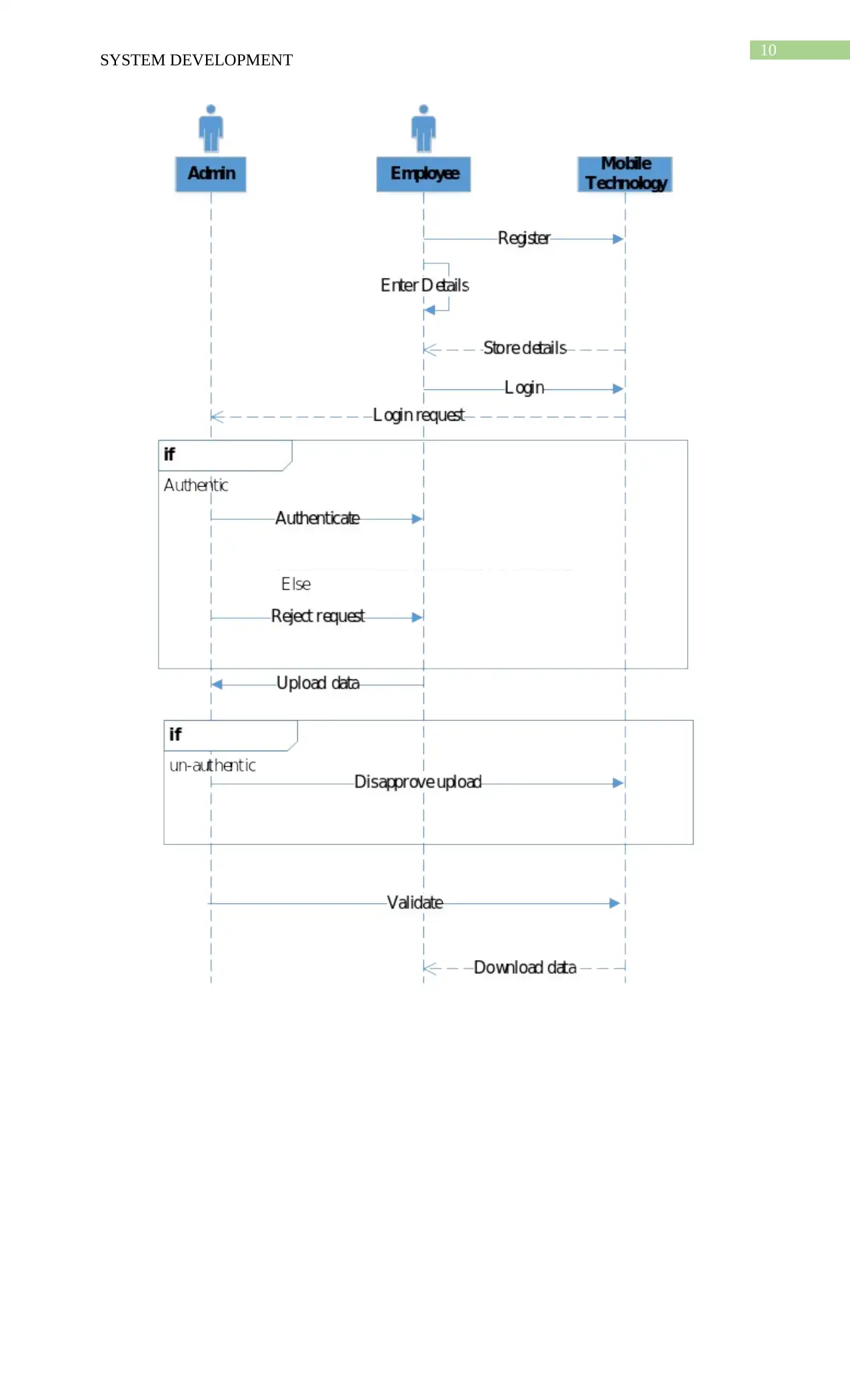
10
SYSTEM DEVELOPMENT
SYSTEM DEVELOPMENT
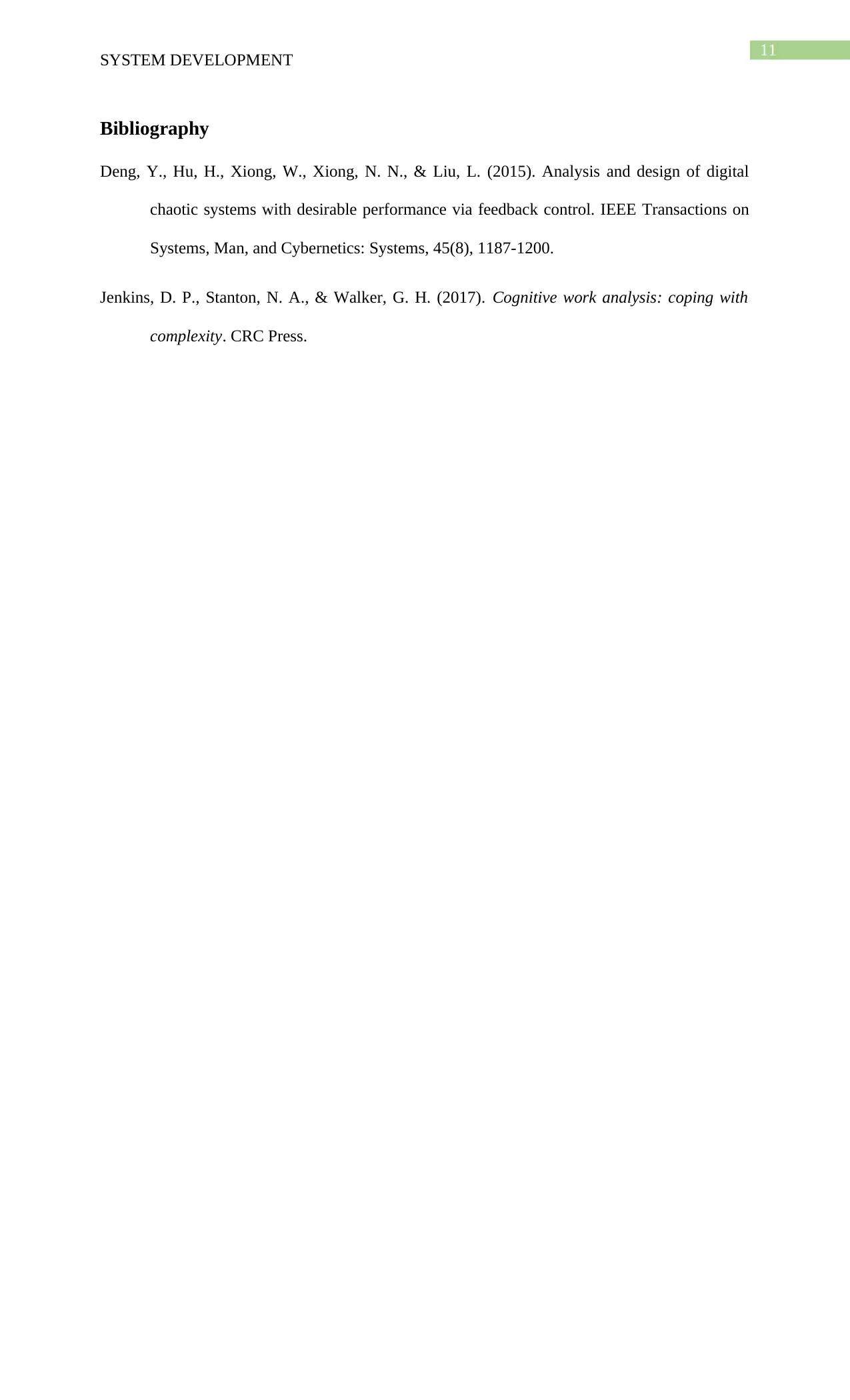
11
SYSTEM DEVELOPMENT
Bibliography
Deng, Y., Hu, H., Xiong, W., Xiong, N. N., & Liu, L. (2015). Analysis and design of digital
chaotic systems with desirable performance via feedback control. IEEE Transactions on
Systems, Man, and Cybernetics: Systems, 45(8), 1187-1200.
Jenkins, D. P., Stanton, N. A., & Walker, G. H. (2017). Cognitive work analysis: coping with
complexity. CRC Press.
SYSTEM DEVELOPMENT
Bibliography
Deng, Y., Hu, H., Xiong, W., Xiong, N. N., & Liu, L. (2015). Analysis and design of digital
chaotic systems with desirable performance via feedback control. IEEE Transactions on
Systems, Man, and Cybernetics: Systems, 45(8), 1187-1200.
Jenkins, D. P., Stanton, N. A., & Walker, G. H. (2017). Cognitive work analysis: coping with
complexity. CRC Press.
⊘ This is a preview!⊘
Do you want full access?
Subscribe today to unlock all pages.

Trusted by 1+ million students worldwide
1 out of 12
Related Documents
Your All-in-One AI-Powered Toolkit for Academic Success.
+13062052269
info@desklib.com
Available 24*7 on WhatsApp / Email
![[object Object]](/_next/static/media/star-bottom.7253800d.svg)
Unlock your academic potential
Copyright © 2020–2025 A2Z Services. All Rights Reserved. Developed and managed by ZUCOL.





